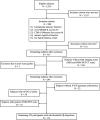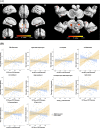Associations Between Sub-Threshold Amyloid-β Deposition, Cortical Volume, and Cognitive Function Modulated by APOE ɛ4 Carrier Status in Cognitively Normal Older Adults
- PMID: 35964194
- PMCID: PMC9535581
- DOI: 10.3233/JAD-220427
Associations Between Sub-Threshold Amyloid-β Deposition, Cortical Volume, and Cognitive Function Modulated by APOE ɛ4 Carrier Status in Cognitively Normal Older Adults
Abstract
Background: There has been renewed interest in the deteriorating effects of sub-threshold amyloid-β (Aβ) accumulation in Alzheimer's disease (AD). Despite evidence suggesting a synergistic interaction between the APOE ɛ4 allele and Aβ deposition in neurodegeneration, few studies have investigated the modulatory role of this allele in sub-threshold Aβ deposition during the preclinical phase.
Objective: We aimed to explore the differential effect of the APOE ɛ4 carrier status on the association between sub-threshold Aβ deposition, cortical volume, and cognitive performance in cognitively normal older adults (CN).
Methods: A total of 112 CN with sub-threshold Aβ deposition was included in the study. Participants underwent structural magnetic resonance imaging, [18F] flutemetamol PET-CT, and a neuropsychological battery. Potential interactions between APOE ɛ4 carrier status, Aβ accumulation, and cognitive function for cortical volume were assessed with whole-brain voxel-wise analysis.
Results: We found that greater cortical volume was observed with higher regional Aβ deposition in the APOE ɛ4 carriers, which could be attributed to an interaction between the APOE ɛ4 carrier status and regional Aβ deposition in the posterior cingulate cortex/precuneus. Finally, the APOE ɛ4 carrier status-neuropsychological test score interaction demonstrated a significant effect on the gray matter volume of the left middle occipital gyrus.
Conclusion: There might be a compensatory response to initiating Aβ in APOE ɛ4 carriers during the earliest AD stage. Despite its exploratory nature, this study offers some insight into recent interests concerning probabilistic AD modeling, focusing on the modulating role of the APOE ɛ4 carrier status during the preclinical period.
Keywords: APOE ɛ4 allele; cognitively normal older adults; cortical volume; function; sub-threshold amyloid-β.
Conflict of interest statement
Authors’ disclosures available online (
Figures



Similar articles
-
The Effect of Gender and APOE ɛ4 Status on Brain Amyloid-β Deposition in Different Age Groups of Mild Cognitively Impaired Individuals: A PET-CT Study.J Alzheimers Dis. 2023;94(2):763-775. doi: 10.3233/JAD-221166. J Alzheimers Dis. 2023. PMID: 37334590
-
Topographical APOE ɛ4 Genotype Influence on Cerebral Metabolism in the Continuum of Alzheimer's Disease: Amyloid Burden Adjusted Analysis.J Alzheimers Dis. 2016 Sep 6;54(2):559-68. doi: 10.3233/JAD-160395. J Alzheimers Dis. 2016. PMID: 27567846
-
Effect of APOE Genotype on Amyloid Deposition, Brain Volume, and Memory in Cognitively Normal Older Individuals.J Alzheimers Dis. 2017;58(4):1293-1302. doi: 10.3233/JAD-170072. J Alzheimers Dis. 2017. PMID: 28550258
-
Cognitive Improvement After Multi-Domain Lifestyle Interventions in an APOE ɛ4 Homozygous Carrier with Mild Cognitive Impairment: A Case Report and Literature Review.J Alzheimers Dis. 2022;89(4):1131-1142. doi: 10.3233/JAD-220374. J Alzheimers Dis. 2022. PMID: 35988223 Review.
-
APOE genotype and neuroimaging markers of Alzheimer's disease: systematic review and meta-analysis.J Neurol Neurosurg Psychiatry. 2015 Feb;86(2):127-34. doi: 10.1136/jnnp-2014-307719. Epub 2014 May 16. J Neurol Neurosurg Psychiatry. 2015. PMID: 24838911 Free PMC article.
Cited by
-
Automated Scoring of Alzheimer's Disease Atrophy Scale with Subtype Classification Using Deep Learning-Based T1-Weighted Magnetic Resonance Image Segmentation.J Alzheimers Dis Rep. 2024 May 17;8(1):863-876. doi: 10.3233/ADR-230105. eCollection 2024. J Alzheimers Dis Rep. 2024. PMID: 38910943 Free PMC article.
References
-
- Jack CR Jr, Knopman DS, Jagust WJ, Petersen RC, Weiner MW, Aisen PS, Shaw LM, Vemuri P, Wiste HJ, Weigand SD, Lesnick TG, Pankratz VS, Donohue MC, Trojanowski JQ (2013) Tracking pathophysiological processes in Alzheimer’s disease: An updated hypothetical model of dynamic biomarkers. Lancet Neurol 12, 207–216. - PMC - PubMed
-
- Sperling RA, Aisen PS, Beckett LA, Bennett DA, Craft S, Fagan AM, Iwatsubo T, Jack CR Jr, Kaye J, Montine TJ (2011) Toward defining the preclinical stages of Alzheimer’s disease: Recommendations from the National Institute on Aging-Alzheimer’s Association workgroups on diagnostic guidelines for Alzheimer’s disease. Alzheimers Dement 7, 280–292. - PMC - PubMed
-
- Thurfjell L, Lilja J, Lundqvist R, Buckley C, Smith A, Vandenberghe R, Sherwin P (2014) Automated quantification of 18F-flutemetamol PET activity for categorizing scans as negative or positive for brain amyloid: Concordance with visual image reads. J Nucl Med 55, 1623–1628. - PubMed
Publication types
MeSH terms
Substances
LinkOut - more resources
Full Text Sources
Medical
Miscellaneous

